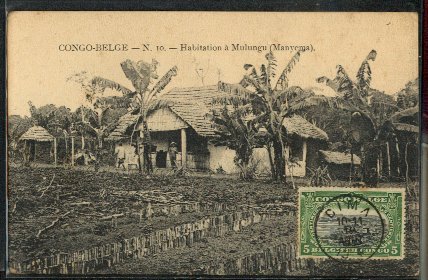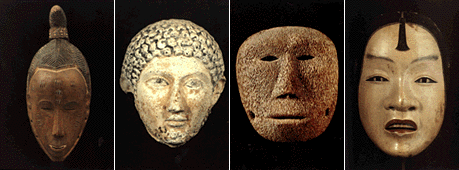

DESOLATION OF THE FORESTS
To the editor of the Brooklyn Eagle:
On December 16, 1899, from the bitter cold weather of Antwerp Belgium, our good steamship Stanleyville
plowed her way across the channel, through the Bay of Biscay on into a tropical ocean and summer weather,
stopping at the Grand Canary islands, Sierra Leone. Cape Coast Castle and anchoring At Banana, just at the
mouth of the mighty Congo River, on the morning of January 4. Traveling up the Congo River is slow work even
for an ocean liner, for there are treacherous and unsuspecting sand bars and very strong currents. At one time
our ship had to be lightened of one hundred and eighty tons of cargo before we could cross a monstrous sandbar
which blocked our way as effectively as a mountain might have done. So it was not until Sunday evening, January 7,
that we completed the distance of seventy miles from Banana to Boma and looked with interest eyes on this
little tropical town, the capital of the Congo Free State.
Boma is a picturesque little place with its low white roofed houses, its cocoanut, and other palm, banana, mango and
baobab trees, and beautiful royal ponciana, a mass of scarlet blossoms, rising like a giant bouquets here and there.
Occasionally, too, one scents and then catches sight of, the sweet frangipanni with its pink and yellow bloom.
The residence of Monsieur E. Wangermee is Gouveneur General de l'Etat Independent du Congo, occupies a fine situation
on a hill commanding a delightful view of the river.
A letter of invitation to call upon him on a certain day and hour was received by us and when we had walked slowly
up the long slope, just a trifle heated by our exertions, we found a very affable Belgian gentleman ready to receive
us most politely and able to speak better English than we could speak French, which, after all, is saying very little.
I am sure progressive American people will be interested in an important event which occurred yesterday, January 10,
illustrative of the slow but sure advance of civilization in Africa. This was nothing less than the opening of the
new railroad which is in process of construction to run northward from Boma into the interior to what is known as
the Mayumba province. For one year and a half the Belgian engineers have been at work and now 32 Kilometers or
21-1/3 miles of track have been laid. This is about one fifth of the entire distance, which they expect, in a
course of time, to cover.
We received invitations most courteously written in French, from the Soceite des Chemins de fer, to Assist at the
inauguration of the section of the line extending from Boma to Luki. Early in the morning in the company with the
captain, the doctor and the chief engineer of the Stanleyville, we made out way to the tiny station and found the
train gaily decorated with the pretty Congo Flags, a large gold star on a field of bright blue. I
our train, with its extremely narrow gauge track, two feet four, its tiny engine and its two cars each twelve feet by
five, were set down in Brooklyn, the inhabitants would turn out en masse to see the toy railroad, and the small boys
would think it made expressly for them. The further one travels from America the smaller some things grow, as, for
instance, railroad trains, luxuries and newspapers. One train, consisting of open trucks with plank seats, had already
gone, but the governor's special train of two coaches was in waiting and in this we were given places, twelve persons
occupying each car. With a shriek of the whistle we were off on our journey. Such winding way.
Ride on a Toy Railroad Planters Raise Coffee and Cocoa and Are Introducing the Rubber Tree.
Belgian Steamer Wrecked
Axim, Guinea Coast, Africa May 24, 1902. The Belgian steamer Stanleyville, from Antwerp about May 8, for the Congo,
has run on the Hoeven Rock, off the Gold Coast, and is a total wreck.
Her sixty passengers, mostly from Antwerp, and
her crew were taken off by steamer Sobo.
The Steamer Stanleyville was built at Middiesborough, England in 1899, and was owned by the Compagnie Beige Maritime
du Congo of Antwerp. She was 370 feet long, had 46 feet 2 inches beam and was 22 feet 8 inches deep.
After ten miles or so of this hilly grandeur our wider outlook began to narrow and we entered the forest,
where enormous baobab trees, tall palms, ash, pawpaw, cotton wood, banana and other trees crowded close,
with huge vines, like ropes, hanging in natural festoons from one to the other, or twisting about the
trunks until they reached the very topmost branches. One of the most interesting sigh5ts wad that of the
tall palms hung with birds nests, tow to three hundred in one tree, looking at a distance as if loaded with fruit.
Besides the birds one saw and as occasional native no signs of life existed, but rather the suggestion of
intense desolation.
We were two hours and a quarter traveling the twenty one miles, but at length Luki was reach and we
found a company of native soldiers a brass band and a goodly assemblage of men gathered to great the
Governor, a alighted to the stirring stains of La Brabanconne, the Belgian national song. A native
band trained by ear alone they did credit indeed to their leader. M Ferdinand Coen, director of the
railroad, made a speech to the Governor, who responded by formally opening the new railroad.
All then adjourned to the little station, where refreshments were provided for the guests of the day.
We had the honor of being the only Americans present and I of being the only lady out of two hundred and
fifty guests. We remained at Luki about an hour and three-quarters.
There is but a single track all the way, but no fear of collision. A train will make the trip and return Monday,
and again each Thursday. The first class fare is 38.74 francs, or $7.50, and the charge for transporting planters,
who are beginning to raise coffee and land have been granted in the interior to planters, who are beginning to raise
coffee and cocoa and to introduce the rubber tree from Brazil. The present source of the rubber in Africa is the vine,
but this doe not yield sufficient to supply the demand, and undoubtedly the Brazilian tree will flourish here and ass
its supply to the commerce of the country.
GERTRUDE WOOD SNYDER
 Congo Flag, Described on Train ride
Congo Flag, Described on Train ride

Boma, Congo Free State, West Africa,
January 11, 1900.

Various Congo masks